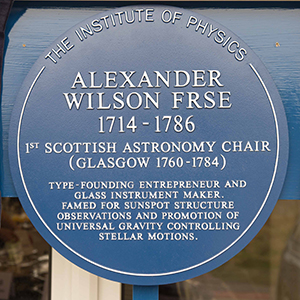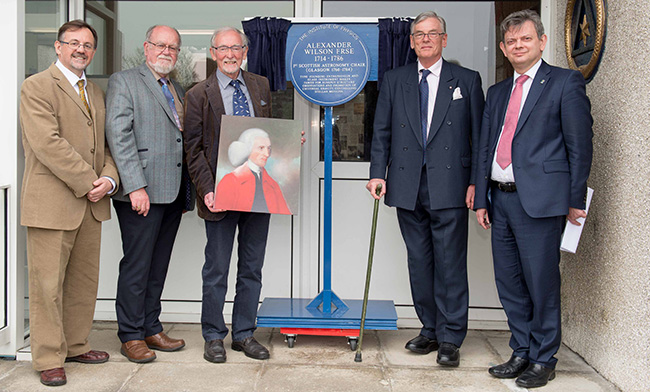Plaque honours a UofG 'great'
Published: 3 April 2017
A plaque has been unveiled to honour one of the great figures from the history of the University of Glasgow, the pioneering Scottish astronomer Professor Alexander Wilson.
A plaque was unveiled last week to honour one of the great figures from the history of the University of Glasgow, the pioneering Scottish astronomer Professor Alexander Wilson FRSE, 1714 - 1786.
 Professor Wilson was a surgeon, type-founder, glassblower and meteorologist. In 1760 he became The University of Glasgow's first Regius Professor of Practical Astronomy running the Old College Macfarlane Observatory with instruments bequeathed by a Jamaica merchant and refurbished by James Watt.
Professor Wilson was a surgeon, type-founder, glassblower and meteorologist. In 1760 he became The University of Glasgow's first Regius Professor of Practical Astronomy running the Old College Macfarlane Observatory with instruments bequeathed by a Jamaica merchant and refurbished by James Watt.
Among his achievements was an early attempt to understand the nature and structure of sunspots. When observing the sunspots at the edge of the Sun he saw them as valleys or caverns in the surface. We now know these to be anomalies caused by the sun's magnetic field. Wilson speculated that the sun's structure had a hotter outer layer covering a dark globe. That interpretation was accepted for more than a hundred years and his observation that sunspots looked like caverns is still referred to by solar researchers as the Wilson Effect.
A blue plaque from the Institute of Physics Scotland was unveiled at Glasgow University's observatory in the West End. It honours him for his work on sunspots and for his theories on gravity.
Masters at 18
Alexander Wilson was born in 1714, the son of the town clerk of St Andrews. He graduated with an MA from the university there when he was just 18 years old. He then spent time as an apprentice surgeon, skilled glassblower and a creator of elegant typefaces.
When he went to work at the University of Glasgow he took his type-founding business with him. His other achievements include the first measurements of temperatures at different levels in the atmosphere by using thermometers carried on kites. He was also able to test how well his solar observation instruments worked by building an "artificial sun" in his laboratory. Other honours include a crater on the Moon bearing his name.
His son Patrick succeeded him to the Regius Professor's chair in 1784.

First published: 3 April 2017
<< 2017 Mar-Apr

